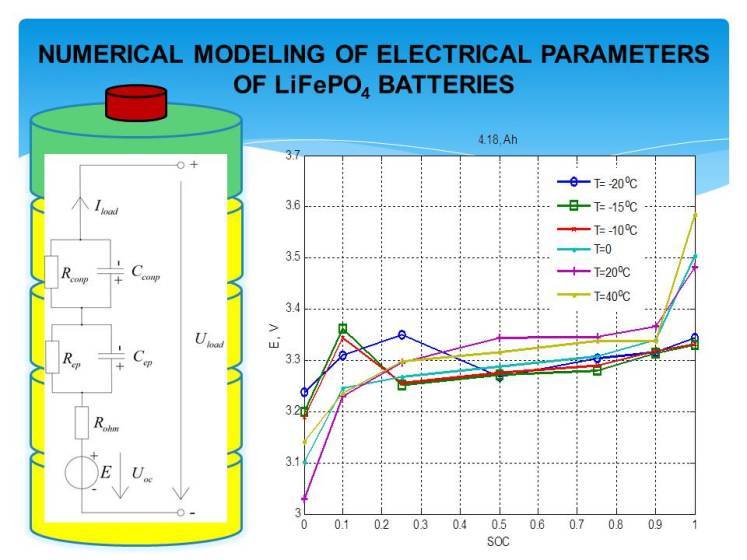Numerical modeling of electrical parameters of LiFePO4 batteries
DOI:
https://doi.org/10.15587/2706-5448.2024.304400Keywords:
lithium-ion battery, electric model, parameters of the equivalent circuit of substitution, state of charge, temperatureAbstract
The object of research is the physical processes of electric energy storage in Li-ion batteries. The problem being solved in the work is related to the lack of reliable mathematical models of storage batteries, which leads to the appearance of undesirable effects or emergency situations when changing operating modes.
In the course of the work, Li-ion battery models based on electrochemical theory and electrical circuits were considered. The six most common equivalent battery replacement schemes are presented. The advantages and disadvantages of the considered substitution schemes are given. The dual-polarization mathematical model was found to most accurately describe the performance of the battery at the end of the discharge and charge cycles compared to the first-order Thevenin model, the RC model, and the active resistance battery model. The physical processes in the storage battery during pulse discharge, which is the main part of electrical energy storage systems based on electrochemical technology, were studied. Mathematical modeling was carried out in the Matlab software package using the Simulink application program package. The dependence of the parameters of the equivalent lithium-ion battery replacement scheme according to the second-order Thevenin model on the ambient temperature and state of charge is considered. It was established that the value of EMF E depends more on the change in SOC than on temperature. In turn, the active resistance ROM shows a greater dependence on temperature than on the change in SOC. At high temperatures, the resistance value decreases. The parameters R1 and C1 characterizing the electrochemical polarization vary in the range from 10 to 75 % SOC. The parameters R2 and C2, which depend on the concentration polarization, vary in the intervals from 0 to 25 % SOC and 75 to 100 % SOC.
The recommendations for choosing a Li-ion battery model developed in the work can be used in practice. The established dependencies will help to better design electrical energy storage systems based on electrochemical technology.
References
- Mitali, J., Dhinakaran, S., Mohamad, A. A. (2022). Energy storage systems: a review. Energy Storage and Saving, 1 (3), 166–216. doi: https://doi.org/10.1016/j.enss.2022.07.002
- Zharkin, A. F., Popov, V. A., Yarmoliuk, O. S., Natalych, V. O. (2023). Features of organization and use of energy storage systems in distribution networks. Power Engineering: Economics, Technique, Ecology, 3, 44–52. doi: https://doi.org/10.20535/1813-5420.3.2022.271492
- Hossain, E., Murtaugh, D., Mody, J., Faruque, H. M. R., Haque Sunny, Md. S., Mohammad, N. (2019). A Comprehensive Review on Second-Life Batteries: Current State, Manufacturing Considerations, Applications, Impacts, Barriers & Potential Solutions, Business Strategies, and Policies. IEEE Access, 7, 73215–73252. doi: https://doi.org/10.1109/access.2019.2917859
- Zhu, G., Wu, O., Wang, Q., Kang, J., Wang, J. V. (2023). The Modeling and SOC Estimation of a LiFePO4 Battery Considering the Relaxation and Overshoot of Polarization Voltage. Batteries, 9 (7), 369. doi: https://doi.org/10.3390/batteries9070369
- Peretvorennia ta akumuliuvannia enerhii vidnovliuvanykh dzherel: laboratornyi praktykum (2022). Kyiv: KPI im. Ihoria Sikorskoho, 80.
- Smyrnov, O., Borysenko, A. (2023). Comparative analysis of electrical models of lith-ium-ion batteries in electric vehicles. Vehicle and Electronics. Innovative Technologies, 24, 50–61. doi: https://doi.org/10.30977/veit.2023.24.0.5
- Plakhtii, O., Nerubatskyi, V., Mashura, A., Hordiienko, D. (2020) The Analysis of Mathematical Models of Charge-Discharge Characteristics in Lithium-Ion Batteries. 2020 IEEE 40th International Conference on Electronics and Nanotechnology (ELNANO). Kyiv, 635–640. doi: https://doi.org/10.1109/elnano50318.2020.9088827
- Odeim, F., Roes, J., Heinzel, A. (2015). Power Management Optimization of an Experimental Fuel Cell/Battery/Supercapacitor Hybrid System. Energies, 8 (7), 6302–6327. doi: https://doi.org/10.3390/en8076302
- Huria, T., Ceraolo, M., Gazzarri, J., Jackey, R. (2012). High fidelity electrical model with thermal dependence for characterization and simulation of high power lithium battery cells. 2012 IEEE International Electric Vehicle Conference. doi: https://doi.org/10.1109/ievc.2012.6183271
- Long, X., Lu, J., Wu, Y., Liu, L. (2019). Research On High Rate Lithium-ion Batteries For Electromagnetic Launcher. 2019 22nd International Conference on Electrical Machines and Systems (ICEMS). doi: https://doi.org/10.1109/icems.2019.8921582

Downloads
Published
How to Cite
Issue
Section
License
Copyright (c) 2024 Mykola Buryk, Vadim Lobodzinsky, Ivan Buryk, Oleksandr Lisovyi

This work is licensed under a Creative Commons Attribution 4.0 International License.
The consolidation and conditions for the transfer of copyright (identification of authorship) is carried out in the License Agreement. In particular, the authors reserve the right to the authorship of their manuscript and transfer the first publication of this work to the journal under the terms of the Creative Commons CC BY license. At the same time, they have the right to conclude on their own additional agreements concerning the non-exclusive distribution of the work in the form in which it was published by this journal, but provided that the link to the first publication of the article in this journal is preserved.








